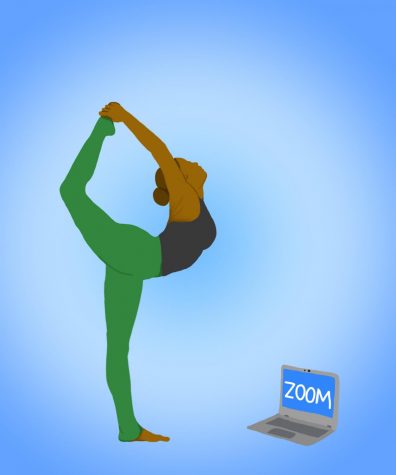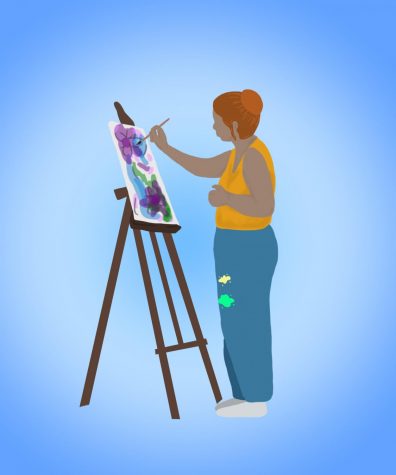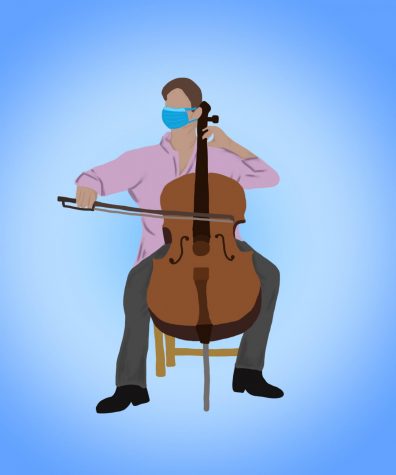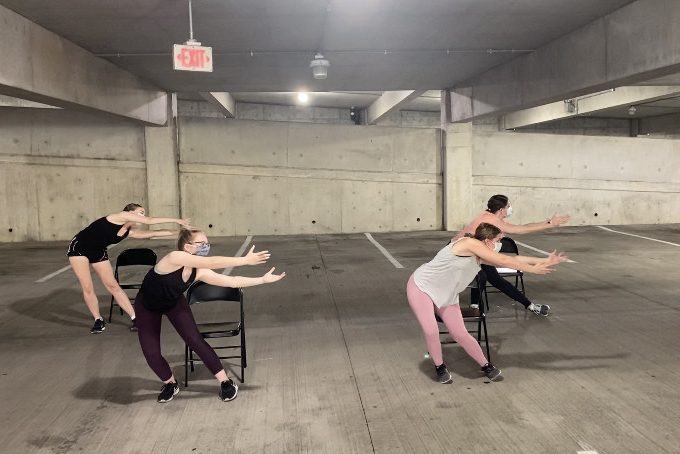Your donation will support the student journalists of Northern Kentucky University. Your contribution will allow us to purchase equipment and cover our annual website hosting costs.
This group is rehearsing for a piece they will perform in this semester’s Emerging Choreographers’ showcase.
How does SOTA operate during a pandemic?
September 23, 2020
NKU’s School of the Arts (SOTA) has decided to utilize digital media as an alternative method to typical live performances, open art galleries and music/vocal lessons in order to ensure a safe, socially distant fall semester for its students, faculty, staff and other patrons.
SOTA department heads and professors shared the changes they made within their respective programs to comply with the university’s social distancing guidelines, how the pandemic has affected the arts community nationwide and how they’re helping students cope with the changes.
Theatre + Dance
Ronnie Chamberlain, SOTA’s area coordinator of design and technology, typically works on three different shows with three different groups of 100 people at a time.
“The general rule for theatre, performing arts is for every one actor you see in a play or a movie or a film, there’s eight other people who made all that happen,” Chamberlain said.
As design and technology coordinator, Chamberlain works particularly with hair, makeup and costumes but also oversees all operations that go into making the production happen.
“Technology is any student that’s not on stage as a performer,” Chamberlain said.

This could include lighting, stage design, sound equipment and orchestra.
In addition to Chamberlain’s role as coordinator, one of the classes she instructs is a business of theatre course that prepares students for work in the technical field of the entertainment industry.
Students in the design and technology field enter the program for theatre, but when they graduate, they work in many fields within the entertainment industry. Employment ranges from ballet, opera theatre, concerts and even the haunted house industry, Chamberlain said.
According to Chamberlain, the entertainment industry, which is commonly the lowest paid and most poorly treated industry in America, is currently redefining itself.
“We’re struggling for a living wage and with COVID, 98% of our industry is currently unemployed,” Chamberlain said.
Eight students in theatre technology graduated last semester and only one was able to carry on with the post-graduation plans they made. The rest all found themselves unemployed—their internships gone, their summer work gone and they’re sitting at home in their parent’s basement trying to figure out what happened, Chamberlain said.
In the next year and a half, an additional 70% of the current design technology students plan to graduate.
According to Chamberlain, as beneficial as filmed productions can be for actors, they are not beneficial to technical students.
“We have chosen as a faculty to not have our students do work that’s not beneficial to them as they’re exiting,” Chamberlain said.
Instead of working on this semester’s filmed productions, guest artists have been recruited to work with design and technology students in a different, engaging way that will help build their portfolios, Chamberlain said.
After the productions initially scheduled for the fall semester were canceled, Michael Hatton, theatre and dance program head, said he felt it was important to offer students the same learning opportunities despite the changes in operation.
According to Hatton, the original fall productions were canceled and replaced with plays that could better accommodate this semester’s entirely virtual performance format while also fulfilling the same number of roles as the previous productions did.
Instead of traditional live audiences, productions will be filmed on the two sound studios currently being installed in the Strauss and Corbett theatres. Two of the plays will be rehearsed, filmed and broadcast free of charge this semester though a web service.
According to Hatton, actors will have up to 45 minutes in the sound studio to film at a time before taking a 30-minute break to allow the air in the space to cycle. Two soundstages will allow the actors and crew to work around this procedure.
In addition to ensuring each soundstage is properly sanitized, hand props, furniture pieces and camera equipment must also be wiped down and sanitized between each performer, Hatton said.
“It’ll be a ‘pay-what-you-can’ donation kind of set up … we wanted to make it easier for people to connect with the arts during this time when the arts are really important for people,” Hatton said.
All actors will be required to do their own makeup and hairstyling at home. They will be coached on how to do so through Zoom by Chamberlain or other student/faculty designers.
“They’ll come to campus, made up, and then we’ll have one actor per dressing room to get into the costume that we have for them,” Hatton said.
To further minimize the contact between actors and tech, costume fittings have been reduced to only one per actor per performance.
“We’ll be doing a lot of costume shopping and having the costumes shipped to us to already fit the body of the actor as opposed to tailoring the costumes and having to do multiple fittings,” Hatton said.
According to Hatton, all rehearsals will be conducted through Zoom or in person. If they are conducted in person, everyone is required to wear a mask just like they would during a class.
In order to safely film an actor on the soundstage without a mask on, they must be the only one in the room. Hatton said the theatre department could’ve filmed performances with multiple masked actors on stage at a time; however, it would’ve been difficult to differentiate who was talking with three quarters of the actors’ faces blocked. It also would restrict an actor’s ability to properly emote.
According to Hatton, 75% of theatre and dance classes are still being held face to face in some capacity. Particularly for dance courses, classes are being held in a few different places on campus.
“The university was really, really supportive and wonderful to us and for dance classes we needed spaces large enough for all 18 students to come together at once, so we have dance classes that are taking place in the rec center.”
Hatton said this arrangement allows dancers to continue to take the technique classes they need to be successful and graduate.
“We can’t just say ‘well, let’s just take this semester off’ because that will hurt them in their career,” Hatton said.
Despite mandatory masks and 12 feet of distance between dancers, Tracey Bonner, dance coordinator, said everybody is excited to be back in the studio together and eager to learn.
Bonner said it was important for classes to be held in person this semester because dance is very community-based and it’s important for dancers to feel a part of an “artistic community.”
“It’s so much about being in the room with everybody else and learning together and when you’re doing that in isolation, it just doesn’t feel the same,” Bonner said.
According to Hatton, the yearly Emerging Choreographers Showcase, which typically invites guest choreographers to work with dancers on a festival-style performance, will be held in a virtual, individual format and will be designed to be site-specific.
“It won’t be one performance edited together, it’ll be multiple pieces that you can pick and choose from,” Hatton said.
According to Bonner, all pieces will include small casts of solos, duets and trios to allow dancers to maintain social distance.
In addition to ensuring her students have safe ways to rehearse and perform, Bonner is also making sure to stress the importance of self-care.
“I implemented a module in class called “Self-care for the Performer” and I’ve got a lot of things in there that are inspirational … and we’re reading a book together that’s called “The Wellness of the Performing Artist” that talks about mental health and nutrition and rest,” Bonner said.
Art
When private art galleries and museums had to close at the beginning of the pandemic, artists had to quickly think of new ways to share their artwork, said David Knight, SOTA gallery director.
In the spring of last semester, the annual Juried Student Exhibition, a gallery for visual arts students, had just opened when the university closed due to COVID-19.
“That’s why when we formed the SOTA page on YouTube to constantly have things every couple of days loaded up on there and we’re going to continue to do that for our program … that’s been the saving thing is getting it out in digital forms,” Knight said.
Although the art galleries have reopened, a digital version of all galleries—including the senior gallery talks and the senior juried art exhibit—will be posted to the YouTube channel. However, gallery access has been restricted to visitation by appointment only.
According to Knight, visitors now make an appointment through a scheduling system in order to limit the amount of people in the gallery at a time.
Knight also teaches the senior exhibit class which revolves around preparing artwork for a gallery. Typically, the class has about seven students, but since visual communication design students only have exhibits in the fall, there will be 22 students exhibiting work between the two galleries, Knight said.
According to Knight, when students begin to set up their exhibits, no more than five at a time will be allowed in the main gallery and only one person at a time will be permitted to set up in the small gallery.
Knight said the gallery setup schedule has completely changed which is also why the show will open much later in the semester. In addition to scheduling, Knight has also had to make sure there will be plenty of tools to allow for sterilization between use.
Kevin Muente, who teaches all levels of painting, has also faced new changes within his classes, specifically with the way students receive feedback.

According to Muente, typically demos would be conducted in class and then he would walk around the room while students worked to help them correct their paintings if needed. Currently, students paint at home and are required to provide a photo of their artwork in progress.
“I’m still doing demos in class via Zoom but also have already recorded the demos and have loaded them on Canvas in case their Wi-Fi goes out or they would have other difficulties,” Muente said.
“I feel it’s all extra work for all of us, but we all seem to be managing well,” Muente said.
Music
Dr. Kimberly Gelbwasser Lazzeri, program head and vocal coordinator, said the music department is facing unique challenges as a program.
According to Lazzeri, there is a long list of safety protocols/distancing requirements that vary depending on the class and type of instrument.
Masks are required at all times for string musicians and singers while brass and woodwind players are permitted to wear their masks on their chin when they play.
“They can pull it down so that they’re able to use their mouthpiece, but then if there’s any talking at all and when they’re not playing, they just pull it right back up,” Lazzeri said.
According to Lazzeri, in-person rehearsals can only be 30 minutes long with a maximum of 12 musicians in an ensemble. Due to social distancing requirements, brass and woodwind players must be distanced 15 feet apart and singers 12 feet. Instructors like Lazzeri have taken advantage of outdoor spaces on campus for rehearsals.
“We have classes happening in the amphitheater, we had classes on the baseball field,” Lazzeri said.
According to Lazzeri, practice rooms are normally first come, first serve, but this semester, rooms can only be reserved for up to an hour and then an hour of vacancy must be kept between each reservation.
“We’re just trying to be creative with the way that we use our spaces and our time so that our students and our faculty are protected as best we’re able to,” Lazzeri said.
Dr. Holly Attar, professor of viola, is also Director of the Music Preparatory Division, a program that provides music education to community members of all ages.
According to Attar, music lessons through the preparatory program will be entirely virtual semester to ensure the safety of the students who are predominantly children.
“For right now online is actually fairly effective because I want to be able to express myself through my facial expression and I want to see theirs as well and while I can hear their playing considerably better when I’m in front of them, and I can model for them in probably a better way, I think there’s a lot lost without facial expression,” Attar said.
However, Attar said she will meet with NKU students one on one in person in a “socially safe, distant way.”

As for classroom/major requirements, Lazzeri said junior and senior recitals will still take place, but students won’t have an audience.
“We hope to have the option in the future to invite some of our students back at some point in time so that they can give their recital and be surrounded by their friends and family,” Lazzeri said.
Despite the changes in performances, Lazzeri and other music professors have continued to connect students with professionals in their field to prepare them in their post-graduation careers.
“We’ve been inviting a lot of guest artists into our Zoom classrooms and I think that is one way that we’ve been helping to prepare our students because these professionals have been able to talk about their experiences in the field, and how their experiences have been affected by this time,” Lazzeri said.
Despite changes in lectures and performances, Attar believes there is no room for giving up and there is no equation to always be successful.
“Art is important, not just because it’s entertainment and beauty and all of those things, but it’s also about discipline and creativity and I think we are showing that,” Attar said.

